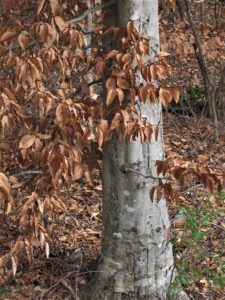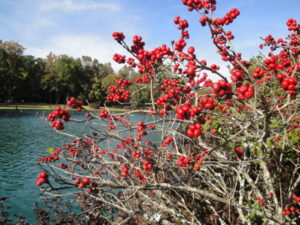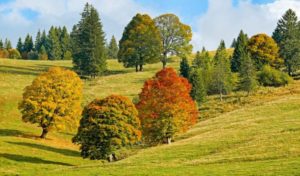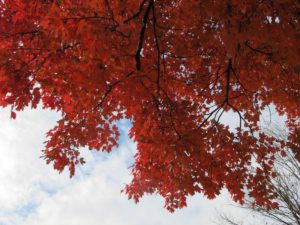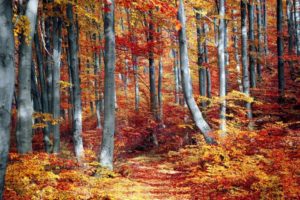Marcescence
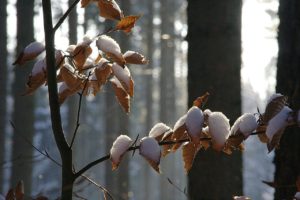
Beech tree.
Oaks (Quercus spp.) sometimes remain in brown leaf until early spring. Beech trees (Fagus grandifolia) can be spotted in the winter forest by their tan leaves dangling from the branches. Leaf retention through winter is called marcescence. The reason for this trait is open to speculation.
Nutrient Release
One theory claims that, by holding onto its leaves until new foliage is about to sprout, those newly fallen leaves will stay near the tree’s root system instead of blowing away in the winter winds.
Since they have yet to begin decomposition, the nutrients locked inside the leaves will be released at a time when they can benefit the tree—when growth resumes in spring.
Browsing Animals
Another theory indicates that browsing animals are less likely to feed on marcescent twigs. In studies where deer were presented with both marcescent twigs and leafless twigs, they chose the leafless twigs.
Weather Abatement
Maybe the dead leaves help slow down fierce winds, protecting the buds from drying out. Even better is the accumulation of snow, as in the photograph (above) of a beech tree, decreasing exposure even more.
Another possibility is the protective shade cast by marcescent twigs on thin-barked trees, such as beech (photo, below). Large differences in temperatures, between night and day, can damage tissues on the south or southwest side (northern hemisphere) of the trunk. Frost cracks and sun scald can be minimized when the trunk is partially shaded by brown leaves during the warm hours of the day.
If cracks occur, callus tissue will seal them, and healthy bark will compartmentalize the wound. There’s no need to paint it with “wound sealer” products. And never fill the cracks or hollows with concrete or dump rocks and debris at the base of a tree!
When a severe early frost suddenly kills a tree’s foliage, the abscission layer would not have had enough time to mature. Consequently, leaves can cling until those cellular changes occur. Young oak trees might exhibit this feature, but it often disappears with maturity. Sometimes only parts of the tree have leaves that cling.
You might have noticed that trees felled in the summer often hold onto their brown leaves.
Why Do Leaves Fall Off?
For a plant to keep its leaves all year long, resources would have to be consumed at a time when they are less efficiently gathered. When light levels are less than optimal, and cold temperatures suppress metabolic processes, it’s easier for the plant to reabsorb nutrients and drop leaves. Water loss, insect predation, foraging animals, and damage from ice, snow, and high winds are some reasons why it just isn’t worth staying in leaf through the winter. The cost is too great.
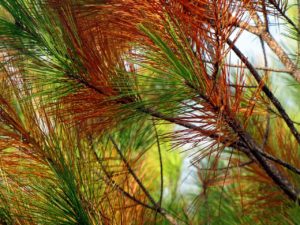
Pine tree with aging needles.
Conifers, on the other hand, have adapted to those conditions, and are able to photosynthesize all year. But they do slow down in cold weather. And the sticky sap in some species (pines, spruce, fir, and others) effectively fends off animals and most insects.
Evergreens drop some of their foliage each year; needles don’t cling forever. Some homeowners are alarmed when they see a large percentage of brown needles fall to the ground. That’s normal, as long as the tips of the stems remain green. A pine needle carpet is an effective mulch.
Protective Red Fall Color
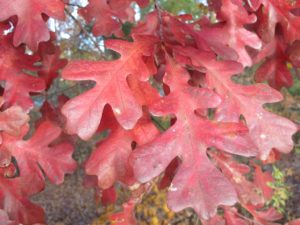
Fall color of white oak.
Scientists have long speculated on the merits of anthocyanins—the red, blue, and purple pigments. Those adhering to the Photoprotection Theory claim that anthocyanins protect leaves from harmful effects of light. This pigment also helps the tree absorb nutrients more efficiently in cooler conditions, before leaf drop.
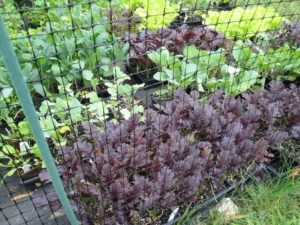
‘Miz America’ mustard greens and other brassicas.
Coevolution Theory claims that insects avoid feeding on leaves high in anthocyanins. The red fall foliage color signals them to stay away, but red berries signal birds to come in for the feast. (***Update***: Growing many flats of colorful fall greens illustrates this point. Among brassicas [mustard, kale, broccoli, cabbage], the deep reddish burgundy ‘Miz America’, one of the mustard greens, is entirely free of damage from caterpillars that ravage green varieties of brassicas. 10/7/2022)
Dogwood trees, hollies, barberry, and pyracantha have red berries that attract birds. After consuming them, the animals help distribute the seeds. Poison ivy has whitish berries that birds eat, but its foliage is fiery red, signaling birds to come around.
Red colors in some species of maple trees are produced by a different metabolic process than through chlorophyll breakdown. These anthocyanins aid in preventing competition with the tree’s own offspring by stunting the growth of saplings trying to grow nearby. This is one type of allelopathy.
But Only Part of the Tree is Turning Color
You might have noticed that a portion of a tree is prematurely turning color while the rest of the tree is still green. I’m not referring to an even coloring at the ends of branches, but rather to the one branch that is conspicuously different in color from the rest of the canopy.
That branch is stressed…
- on the side of the tree where the roots are exposed to hot sun and poor, dry soil, such as on a south-facing slope.
- from root compaction.
- due to root disturbance, from working in the soil under the tree, severing roots.
- because it’s heavily shaded and not contributing to photosynthesis.
- from the tree being coppiced, or cut back to the ground. As several stems regrow, the dominant ones interfere with the others. Weaker stems will show early color and die.
- due to girdling roots. Maple trees are notorious for this. Look for and sever a root that crosses over the base of the trunk. The trunk will try to grow over the root but could end up being constricted. Look up that part of the trunk, and you might see branches that are developing early fall color. One indication of a girdling root is the absence of an even flare all around the base of the tree. One side of the trunk will look flat where it enters the ground.
- from clotheslines, hammock ropes, or other items tied around the trunk or branches, eventually girdling the stem.
- where lightning or physical damage stripped bark off the side of a trunk, killing parts of the tree above the damage which no longer receive water and nutrients.
- from insects and diseases causing disruption in the flow of water and nutrients, affecting parts or all of the tree canopy. This can happen at the base of a leaf, a twig or branch, in the trunk, or in the roots.
Fall Color and Species Distribution
Some parts of the world are known for their fall color. Southern Canada, parts of the northern U.S., Scandinavia, northern and western regions of Europe north of the Alps, the Russian Caucasus region, Japan, parts of China, the Korean peninsula, Argentina, Chile, southern Brazil, and New Zealand’s South Island are some.
Certainly, there are pockets in millions of places around the world with absolutely dazzling fall displays! One option is to create your own by including in your landscape a few specimens with spectacular fall color.
In this country, changes in color begin as early as September in the higher elevations of the Rocky Mountains, far north Minnesota, and upper New England (far north New York state, Vermont, New Hampshire, and southwest Maine). Southern states, part of the Atlantic coast, and the California interior between mountain ranges begin their autumn displays in November. Check out this map, where you can see how fall color progresses throughout the country.
Speaking of Cold
North America is home to a diverse habitat of 800 species of trees, including 70 oaks. Northern Europe has fewer—51 species, 3 of which are oaks. These numbers do not include cultivars of the species. One thing scientists can agree on: they can’t agree on the number of tree species inhabiting the planet! Some say the number is under 50,000, and others estimate over 100,000 species.
During the Ice Ages, North American tree species in southern regions and along the north-south mountain ranges were spared extinction caused by glaciers. As glaciers expanded from the north, trees were able to find refuge south of their original range. Seed dispersal took place over thousands of years, with wind, water, and animals distributing seeds into new territories. The last Ice Age occurred from 18,000 years ago to approximately 12,000 years ago. By 16,000 years ago, temperatures began to rise.
However, in Europe, glaciers covered a larger area of land. The Alps acted as a massive barrier to species trying to retreat toward southern latitudes. Those trees were cornered, and then covered up by mile-thick sheets of ice, causing mass extinctions. This explains the disparity in the number of tree species between North America and Europe.
At the height of the last Ice Age, about 18,000 years ago, glacial ice covered one third of the planet’s land surface. Today, about 10% of the land is covered by ice.
Fall color is nature’s last hurrah of the season.
While many dread the coming winter season, autumn color can help ease the transition. I hope you’ll consider planting trees and shrubs that have brilliant autumn color.
One of my favorite shrubs for deep red to burgundy fall color is Itea virginica ‘Henry’s Garnet’. Also called Virginia sweetspire, this native suckering plant has lovely white flowers in spring, deer-proof foliage, and beautiful long-lasting fall color. (***Update***: Despite abnormally frigid temperatures in the winter of 2024-2025, the last leaves on one of the plants in my garden clung until New Year’s Day! 1/23/2025)
If you’re not planning to do any landscaping, you can still enjoy the colors of autumn by visiting parks and public gardens, or by taking a leisurely stroll through the neighborhood. Maybe it’s time for a road trip. Don’t forget the camera!
Headings
Page 1: Plant Pigments and Fall Color, Chlorophyll, Carotenes and Xanthophylls (Brown as a Fall Color), Anthocyanins, Variety Selection in Your Landscape, Fall Color Depends on Weather, Hormones and Abscission
Page 2: Marcescence (Nutrient Release, Browsing Animals, Weather Abatement), Why Do Leaves Fall Off?, Protective Red Fall Color, But Only Part of the Tree is Turning Color, Fall Color and Species Distribution, Speaking of Cold, Fall color is nature’s last hurrah of the season.
